Up Next
In Her Cinema-Inspired Paintings, Eunnam Hong Captures the Uneasiness of the Alternative Identities We All Put On
The artist's New York debut "Souvenirs" is on view at Lubov NYC through June 18.
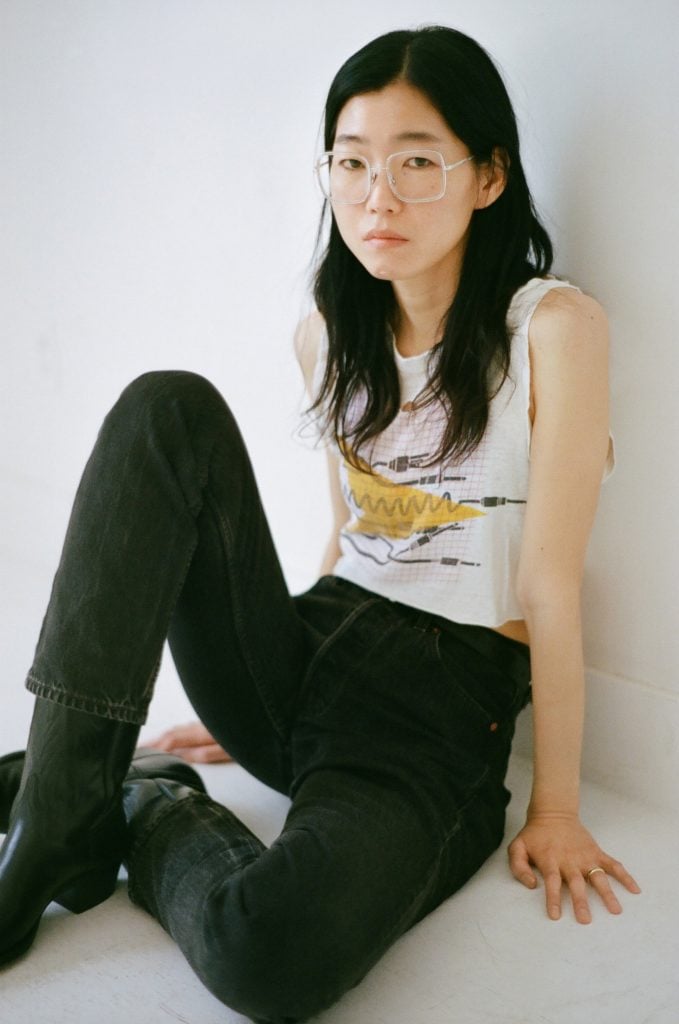
The artist's New York debut "Souvenirs" is on view at Lubov NYC through June 18.

Katie White

We are strangers, even to ourselves.
That seems to be the message of “Souvenirs,” the New York debut of Brooklyn-based artist Eunnam Hong now on view at Lubov NYC, which leaves a lingering aftertaste of unease with viewers, as familiar surroundings feel subtly changed, filled with hidden desires and latent potentials.
Hong herself is the model for each of the subjects—or “characters” as she calls them—in the 10 acrylic-on-linen works on view in the exhibition. Sometimes she stands in the scene alone or is twinned, and in one case she appears as a set of five characters each sporting a handkerchief.
While the artist is recognizable in these paintings, the works are not self-portraits in any traditional sense. Instead, Hong appears in exaggerated, almost awkward poses, donning costumes that feel plucked from the films of avant-garde director Wong Kar-wai or the glossy pages of fashion magazines. Opulent wigs with platinum or brunette curls sit atop her head in almost every painting, taking on the appearance of characters in their own right, an octopus of hair, almost.
Hong paints in a studio in her Park Slope home and a familiar eye will recognize certain architectural attributes of the neighborhood’s brownstones—prewar moldings, high ceilings, outlet covers thick from layers of paint. Looking from painting to painting, one can begin to get a sense of a space, filled with midcentury furniture, that feels real, concrete, and personal, if not completely cohesive.
The femme figures positioned throughout the canvases however feel decidedly more illusory, figments of the imagination.
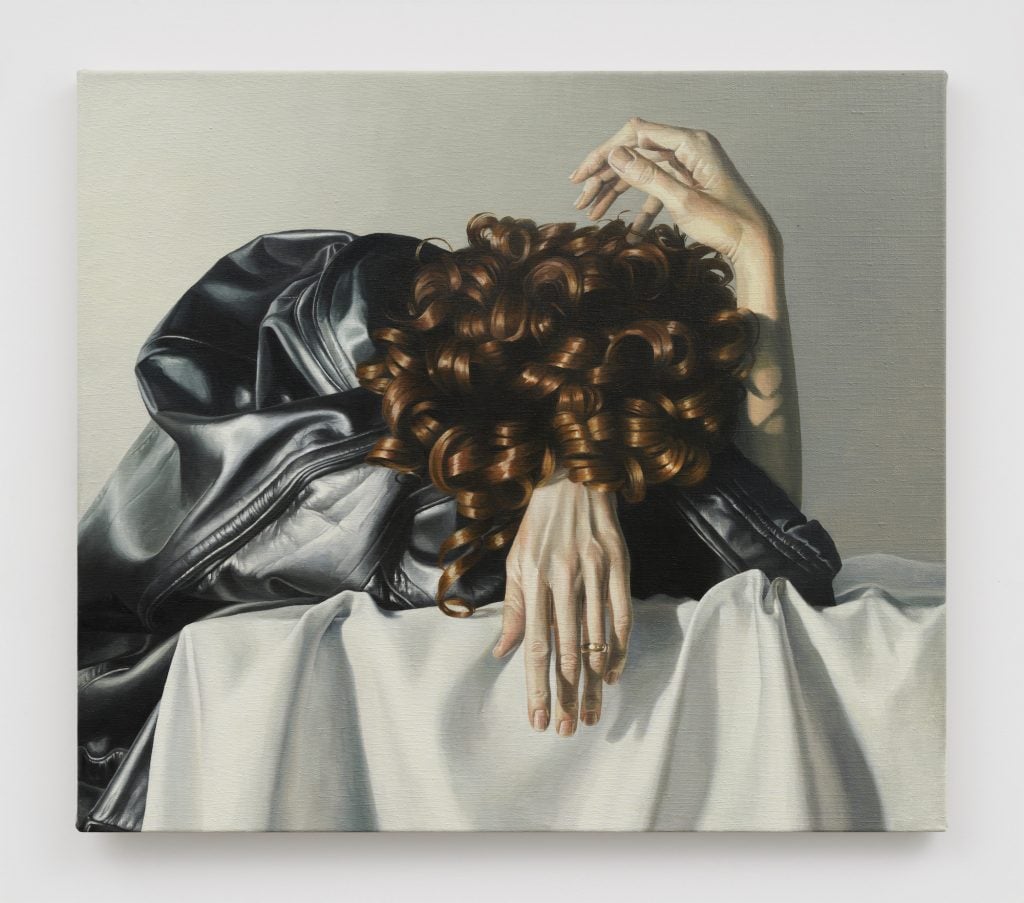
Eunnam Hong, Myth (2023).
Over the past two years, these peculiar and provocative images have enticed interest from art world insiders and collectors. But ascendence in the art world hasn’t come easily for Hong.
Born in Gangwon-do, South Korea, Hong dreamed of studying painting, but her parents urged her toward more practical possibilities; ultimately she studied graphic arts at the prestigious Seoul Institute of the Arts, as an internal compromise.
After college, she launched into a career as an art director, working often in the world of fashion and taking on projects with industry leaders, such as Edward Enniful. In these positions, Hong honed her eye for material culture, developing a precise familiarity with fashion and, perhaps most importantly, learning the possibilities of representation behind the camera.
After nearly a decade working in that industry, Hong was still eager to pursue painting, and she moved to New York in 2006 on what was meant to be a year-long sabbatical. Her paintings from this era delve into contemporary plastic surgery, and while she pursued these works in earnest, they left her somewhat dissatisfied.
Life, with all its unexpected complexity, detoured her plans, too. Hong met an American man, now her husband, and the sabbatical transformed into a permanent relocation. Then she gave birth to her son, who is now nine years old.
For Hong, these new roles—wife and mother—were a seismic reconsideration of self and she started grappling with her own identity and the idea of multiples. A moment of transcendence occurred a few years ago when Hong, on a lark, stepped behind a camera—and then in front of it—capturing images of herself. The disconnect she felt from the person in the pictures opened a space for her to consider all she might not know about herself, and the ways, as an Asian artist who moved to the U.S. in adulthood, she might be perceived as ‘other,’ in ways she does not see herself.
“The lens has a different way of seeing things,” Hong said in a conversation at Lubov. “I thought I knew who I was and what I looked like, but the photographs delivered a completely different image of myself. It was quite fascinating to me.” Photographing herself in costumes became a jumping-off point for constructing paintings that explored complex and contradictory emotions.
“These characters come from my interior world. I’ve been thinking a lot about the domestic environment and my life over the past decade,” Hong explained. “There are psychological uniforms that I’ve worn over the years—as an artist, a mother, a wife—in relationship to the external world. I wonder how that shapes the relationship to myself, and the certain things I do or don’t do.”
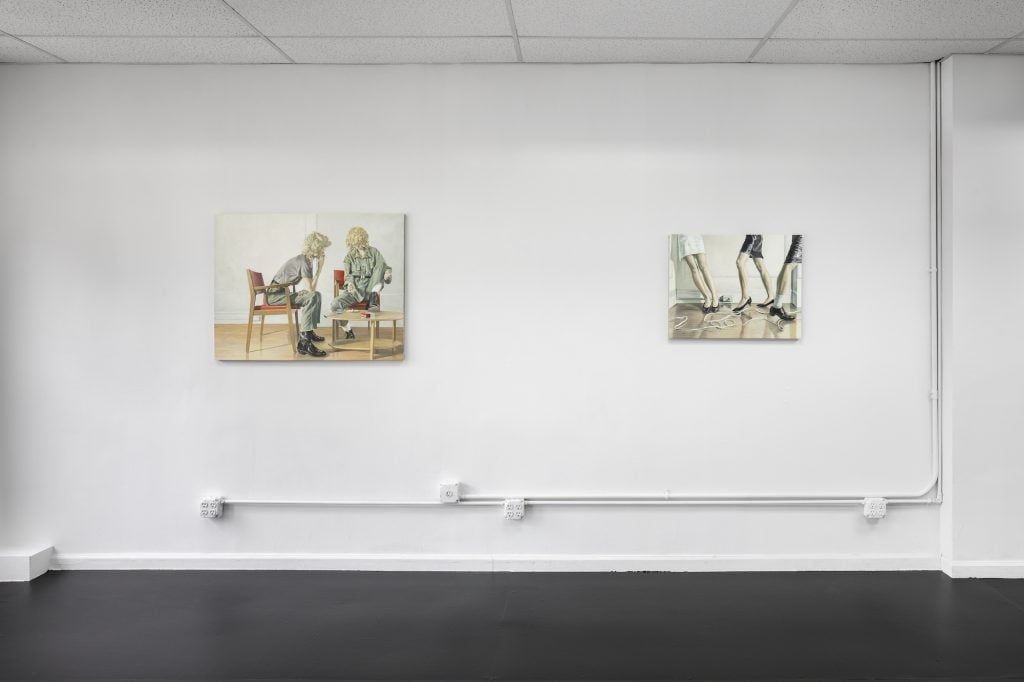
Installation view “Eunnam Hong: Souvenirs,” 2023. Courtesy of Lubov NYC.
To construct her paintings, Hong works early in the mornings, first sketching ideas of what she wants to convey. Then she begins taking photographs of herself at various angles and ensembles. She sources her clothing from vintage shops, among other sources. These ensembles are more than stage settings; they are the very souvenirs the exhibition title refers to. “Clothing is a very collective experience,” Hong said. “We all participate in fashion in our own way.”
Souvenirs are kept to memorialize journeys, but also for their talismanic ability to stir memory—the word itself derives from the French meaning “to remember” or “come to mind.” In Hong’s artfully crafted compositions, attire can conjure up an entire era.
In the painting Jean Jacket (2023), for example, an androgynous figure clad in blue jeans appears multiple times: lying on a bed, kneeling, leaning against a doorway. The painting is redolent of 1990s heroine chic editorials. What Hong offers us isn’t nostalgia or comedy, but an image that is provocatively private and strange. The characters seem to be trapped waiting for the story to continue on, for someone to open the door. The souvenir of the jean jacket belonging maybe to a lover, perhaps, waiting somewhere beyond the canvas, or perhaps still, a souvenir of a younger self.
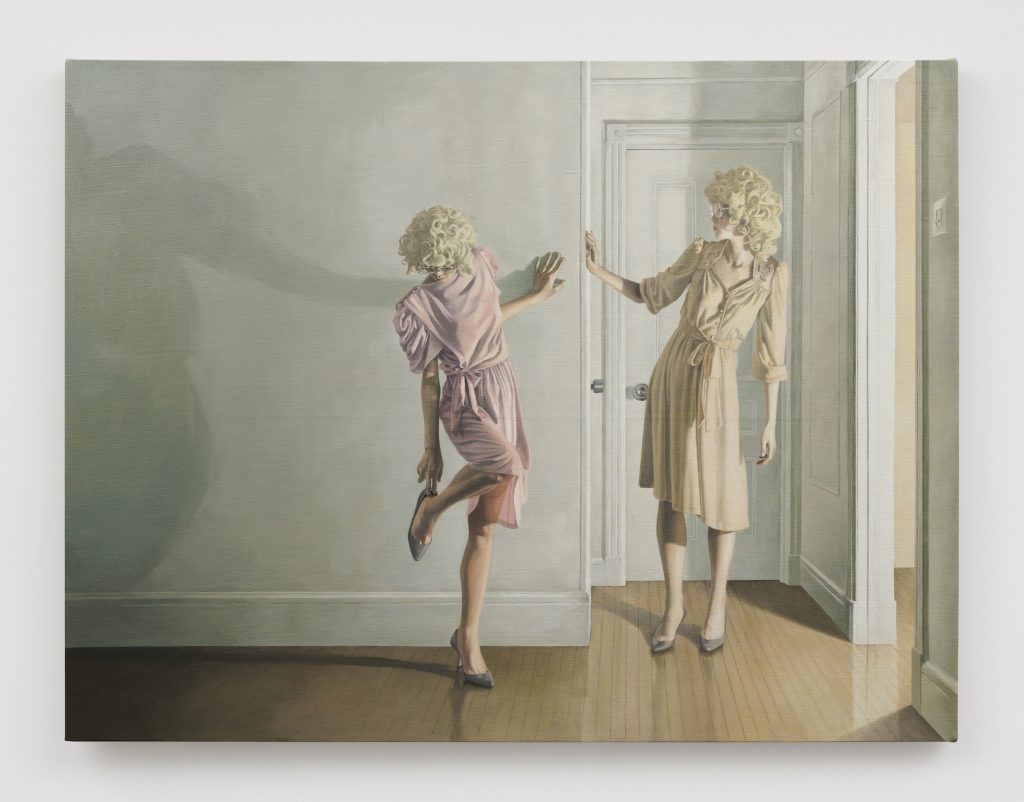
Eunnam Hong, Dresses (2022). Courtesy of Lubov NYC.
In another work, Dresses (2022), two identical blonde women, painted with an unreal alabaster whiteness, lean against the walls of an apartment entryway, wearing dresses—one tan and one the palest pink—that situate the scene in the late 1970s or early 80s. The women, again, appear to be waiting, claustrophobically trapped as they keep company only with themselves, their own thoughts, and their own timeline.
Talking to Hong, I mention a confluence with Vermeer—the staging, the light pouring in at specific angles, and the repeated use of the same garments as props for models, all feel similar to the Dutch master. Vermeer has often been hailed for his proto-cinematic style, and Hopper—who Hong has also earned comparisons to—for his influence on filmmakers. But Hong says she is more influenced by movies themselves, rather than the canons of art history. Growing up in Gangwon-do, a city without a strong visual arts culture, Hong says that films were her primary mode of consuming avant-garde culture.
In that light, the blond wigs that dominate her paintings assume new meanings. Wong Kar-wai’s film Chungking Express (1994) and the enigmatic “Woman in a Blonde Wig” character played by Taiwanese actress Brigitte Lin immediately come to mind. Wong’s filmmaking, which is famed for its non-sequential storytelling, offers fresh possibilities for how one might approach Hong’s works, too. Time and events are conflated and flattened, similarly to a Medieval painting. Everything happens at once, and also distinctly.
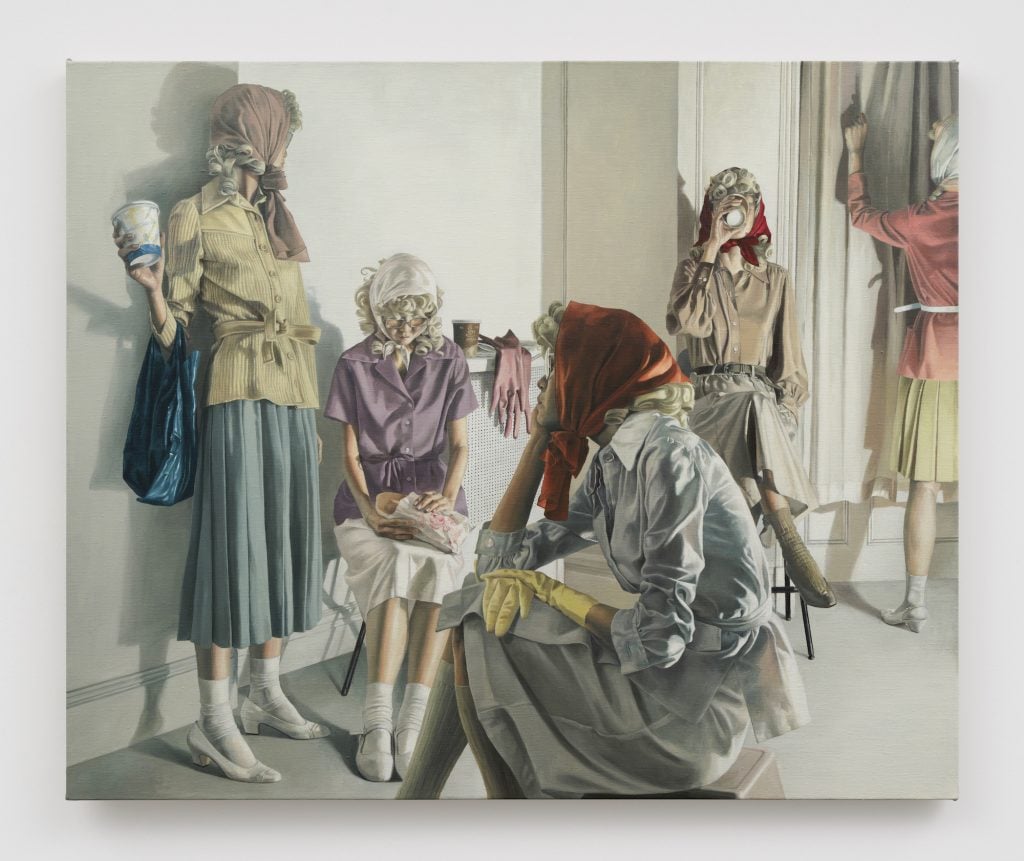
Eunnam Hong, Lunch Break (2023). Courtesy of Lubov NYC.
The director John Cassavetes is another influence. Hong says she is interested in what it means to age as a woman and the roles we are asked to occupy. “Gena Rowlands” is an example we both cite at the same time, and there is a clear similarity between Hong’s paintings and the actress’s appearance in her husband’s films, particularly A Woman Under the Influence (1974), which was the title of Hong’s first solo show at Los Angeles’ de boer gallery in 2022. The film follows a working-class man and his attempts to maintain a semblance of normality in a household where his wife, played by Rolands, descends deeper and deeper into a mental breakdown.
“Rowland’s characters are both completely relatable and very dark,” Hong said. “I crossed a point, especially when I had my child, when I realized that I was living in these layers of roles—my new identity as mom or wife. It was distressing and I got to a point where it shattered my notion of my individualism as an artist. That idea of: ‘This is who I am, with heart and passion,'” she explained, “I was shaken but also drawn toward these unpleasant feelings.”
Another cinematic comparison that comes to mind when viewing Hong’s paintings are Rainer Werner Fassbinder’s women protagonists, in films such as The Bitter Tears of Petra von Kant (1972) or The Marriage of Maria Braun (1978), which center on complex love affairs. “These characters let me play out the feelings I’m trying to name,” Hong said.
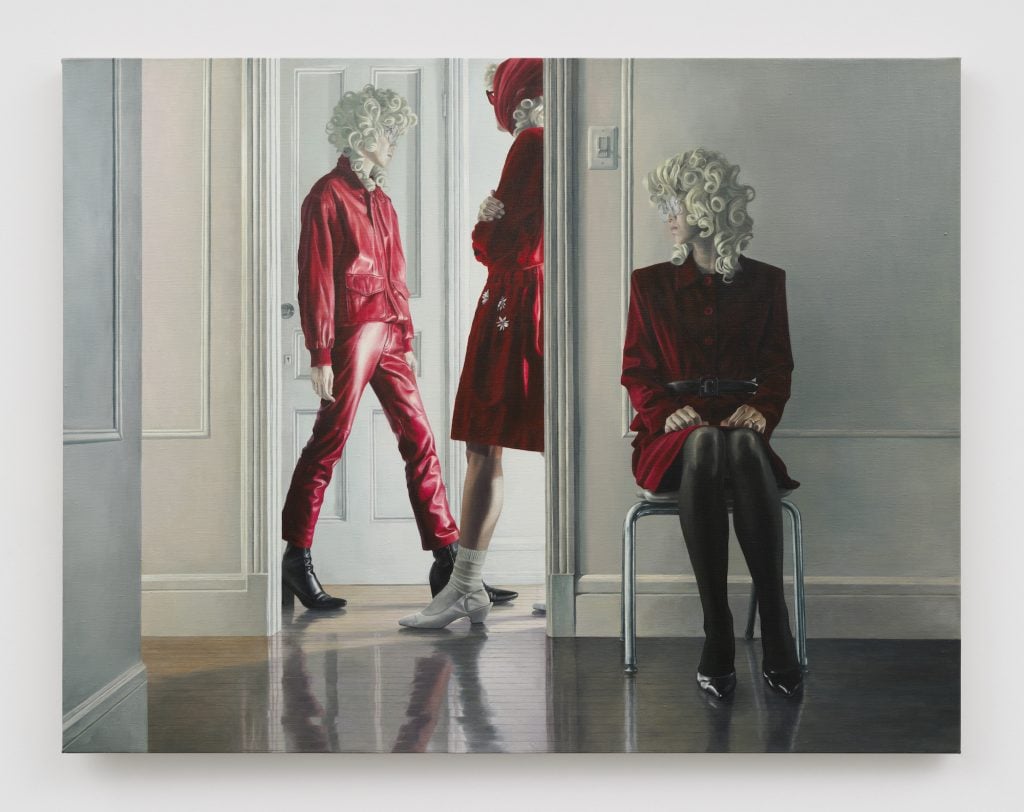
Eunnam Hong, Enemy (2023). Courtesy of Lubov NYC.
Hong’s paintings, much like these films, explore women’s roles in and out of the home. For Hong, working inside the home as a painter has left her considering what work really looks like. “Being an artist is an ambiguous identity—you feel very certain about what you’re doing but you can also feel very isolated. It’s hard to situate yourself in terms of work and labor,” she said.
Her painting Lunch Breach presents the character of a woman enjoying some downtime in five vignettes. Takeaway coffee cups and head scarves abound. For Hong, the image is redolent of Hong Kong, and of the Asian food stands and takeaway lunches she is nostalgic for. But the images also speak to the lives we imagine for ourselves, for the other selves that might have been.
In the eerily sci-fi painting, Enemy (2023), for example, three figures appear clad entirely in crimson. One character is seated in a chair, in a darkened room, perhaps unaware of these other versions of herself in the illuminated hall behind her. The painting is tense with a sense of conspiracy. These other-selves, Hong seems to say, may still exist and are not necessarily on our side.